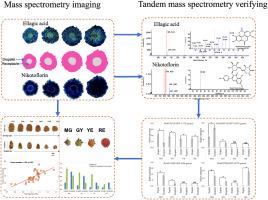红莓果实中生物活性物质的动态分布与生物合成:影响其含量的因素
IF 5.7
2区 生物学
Q1 PLANT SCIENCES
引用次数: 0
摘要
青藤,以其饮食和药用特性而闻名。这种水果的类黄酮和鞣花酸/鞣花单宁对它的味道、风味和医药应用都是必不可少的。本研究利用质谱成像(MALDI-TOF IMS)和串联质谱(MS/MS)研究了果实组织、成熟阶段和种质收集中的这些植物化学物质。此外,我们结合转录组学数据和qPCR来探索关键生物合成基因之间的关系。结果表明,山奈酚苷元主要富集在核桃核中,花青素、槲皮素苷元和鞣花酸/鞣花单宁主要富集在花青素容器中。山奈酚苷元也聚集在附着在核仁外层的大量毛发中。这些化合物在成熟的绿色阶段(MG,成熟的最早阶段)最丰富,随着果实的成熟在核桃核和花托中逐渐减少。在黄酮类途径中,关键基因RchFLS在核桃核中的表达高于在花托中的表达,而RchDRF在花托中的表达高于在核桃核中的表达。在鞣花酸途径中,限速基因RchGT2在受体中的表达高于在核桃核中的表达。这些黄酮类化合物和鞣花酸/鞣花单宁在核桃核和花托中的不同表达是其分布不均匀的原因。此外,随着果实成熟,这些基因的表达几乎下调,这与黄酮类化合物和鞣花酸/鞣花单宁的下降有关。反映花托比例的果形指数(FSI)与果实中总鞣花酸含量呈正相关(R = 0.704, P < 0.0001)。这些发现可以帮助育种者通过形态选择更容易地改良具有药用价值的品种,并帮助生产者在适当的时间收获用于药用或食品市场的果实。本文章由计算机程序翻译,如有差异,请以英文原文为准。

Dynamic distribution and biosynthesis of bioactive compounds: Determining factors for their content in Rubus chingii fruit
Rubus chingii, is renowned for its dietary and medicinal properties. The fruit's flavonoids and ellagic acid/ellagitannins are essential for its taste, flavor, and pharmaceutical applications. This study investigates these phytochemicals across fruit tissues, maturation stages, and a germplasm collection using mass spectrometry imaging (MALDI-TOF IMS) and tandem mass spectrometry (MS/MS). Furthermore, we integrated transcriptomic data and qPCR to explore the relationship between key biosynthetic genes. As a result, kaempferol aglycones were predominantly accumulated in the drupelets, while anthocyanins, quercetin aglycones, and ellagic acid/ellagitannins were primarily in the receptacle. Also, kaempferol aglycones were accumulated in numerous hairs attached to the outer layer of the drupelet. These compounds were the most abundant at the mature green stage (MG, the earliest stage of maturity) and decreased with fruit maturation in both drupelets and receptacles. In the flavonoid pathway, the key genes, RchFLS, had a higher expression in drupelets than in the receptacle, but conversely, RchDRF had a higher expression in the receptacle than in drupelets. In the ellagic acid pathway, the rate-limiting gene RchGT2 had a higher expression in receptacles than in drupelets. Their different expressions between drupelets and receptacles were responsible for the uneven distribution of these flavonoids and ellagic acid/ellagitannins. Moreover, the expression of these genes was almost downregulated as the fruit matured, which was associated with a decline in flavonoids and ellagic acid/ellagitannin. Fruit shape index (FSI) reflecting the proportion of the receptacle was positively correlated with total ellagic acid content in the fruits (R = 0.704, P < 0.0001). These findings could help breeders easily improve cultivars for pharmaceutical value with morphological selection, and producers harvest fruits at the right time for either medicinal purposes or the food market.
求助全文
通过发布文献求助,成功后即可免费获取论文全文。
去求助
来源期刊
CiteScore
11.10
自引率
3.10%
发文量
410
审稿时长
33 days
期刊介绍:
Plant Physiology and Biochemistry publishes original theoretical, experimental and technical contributions in the various fields of plant physiology (biochemistry, physiology, structure, genetics, plant-microbe interactions, etc.) at diverse levels of integration (molecular, subcellular, cellular, organ, whole plant, environmental). Opinions expressed in the journal are the sole responsibility of the authors and publication does not imply the editors'' agreement.
Manuscripts describing molecular-genetic and/or gene expression data that are not integrated with biochemical analysis and/or actual measurements of plant physiological processes are not suitable for PPB. Also "Omics" studies (transcriptomics, proteomics, metabolomics, etc.) reporting descriptive analysis without an element of functional validation assays, will not be considered. Similarly, applied agronomic or phytochemical studies that generate no new, fundamental insights in plant physiological and/or biochemical processes are not suitable for publication in PPB.
Plant Physiology and Biochemistry publishes several types of articles: Reviews, Papers and Short Papers. Articles for Reviews are either invited by the editor or proposed by the authors for the editor''s prior agreement. Reviews should not exceed 40 typewritten pages and Short Papers no more than approximately 8 typewritten pages. The fundamental character of Plant Physiology and Biochemistry remains that of a journal for original results.

 求助内容:
求助内容: 应助结果提醒方式:
应助结果提醒方式:


